Introduction
The San Joaquin Valley is located in central California and it is one of the top agricultural production sites in the United States. San Joaquin Valley has become an area of interest in environmental injustices due to the large minority populations and high contamination of arsenic in their groundwater. We will explore this environmental injustice further in an attempt to bring awareness to the people that have been affected, and remediation to prevent further exposure.
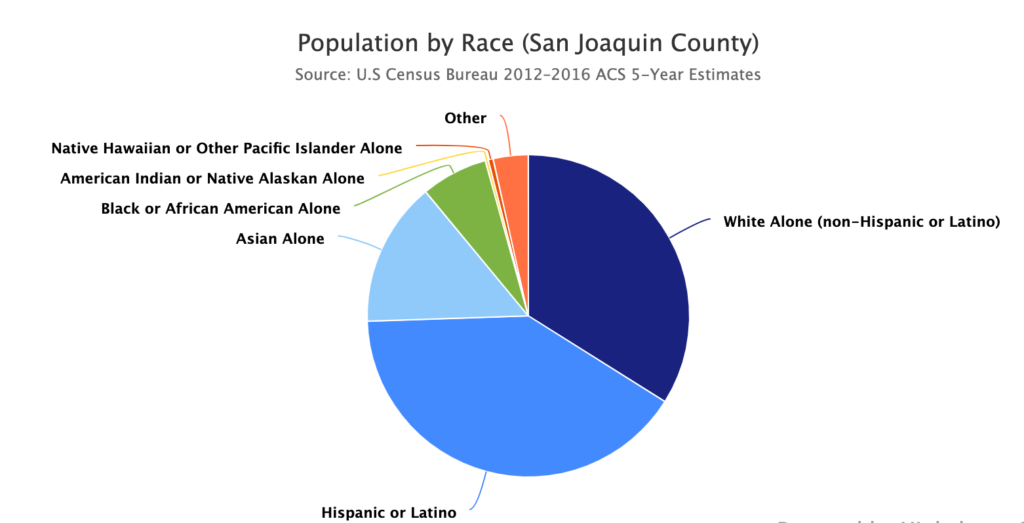
Figure 1. The population by race demographic in San Joaquin County. This is one of the eight counties which make up the San Joaquin Valley and is representative of fairly similar demographics from county to county. All of this information is compiled by the U.S. Census Bureau (2016).
What is Arsenic?
Arsenic is a naturally occurring mineral that has many health implications when consumed at high levels. It is ubiquitously found in most water aquifers as it is absorbed by the sediments. When the levels are not closely monitored humans who rely on these aquifers for drinking water are at risk of serious health problems. According to the World Health Organization, long exposure to drinking water that has been contaminated with high levels of arsenic can cause cancer, skin lesion (Fig. 2), and it has also been associated with cardiovascular disease and diabetes (WHO 2018).
 Figure 2. Image depicting skin lesions, a health effect of arsenic exposure (Wikimedia 2019). Ingestion of arsenic in high levels can lead to arsenic poisoning, which can have serious side effects such as skin lesions (Medscape 2018).
Figure 2. Image depicting skin lesions, a health effect of arsenic exposure (Wikimedia 2019). Ingestion of arsenic in high levels can lead to arsenic poisoning, which can have serious side effects such as skin lesions (Medscape 2018).
San Joaquin Valley (SJV) accounts for 10% of all groundwater pumping and drinking water in the United States (Haugen et al. 2021b). Arsenic becomes toxic to humans and other animals at high concentrations but it has not been an area of concern until recent years. In 2001, the U.S. Environmental Protection Agency decreased the maximum contaminant level for arsenic from 50 μg/L to 10 μg/L (Haugen et al. 2021b). The figure below shows the areas around the world that have high contamination levels of arsenic, note the large concentration of contaminants in the San Joaquin Valley.
 Figure 3. Image depicting arsenic contamination areas over the entire globe (Wikimedia 2012). There is significant arsenic contamination in the Americas, as well as, Asia and parts of Europe.
Figure 3. Image depicting arsenic contamination areas over the entire globe (Wikimedia 2012). There is significant arsenic contamination in the Americas, as well as, Asia and parts of Europe.
The increase of Arsenic in the groundwater is attributed to the over pumping of that aquifer, with over pumping there is stress added to the aquifer system that results in high vertical hydraulic gradients that cause a larger volume of water to be drawn from less-permeable clays releasing water with high arsenic concentrations (Smith et al. 2018). Over pumping has become an increasing issue that is leading to the sinking of the valley by as much as 28 feet in some areas (San Joaquin Valley Is Still Sinking 2016).
Arsenic’s Mechanisms and Effects on Humans
When Arsenic releases toxic effects it causes dysfunction of cellular respiration due to the inhibition of several mitochondrial enzymes followed by oxidative phosphorylation uncoupling resulting in the death of the cell (Prakash 2015). The mechanism of Arsenic toxin release is not fully understood yet but several theories vary depending on the type of arsenic. Humans who have long-term exposure to arsenic run the risk of developing epithelial changes, cancer, diabetes, cardiovascular disease i.e. heart failure, and in pregnancy, the baby is likely to have cognitive dysfunction and die at a younger age (Prakash 2015).
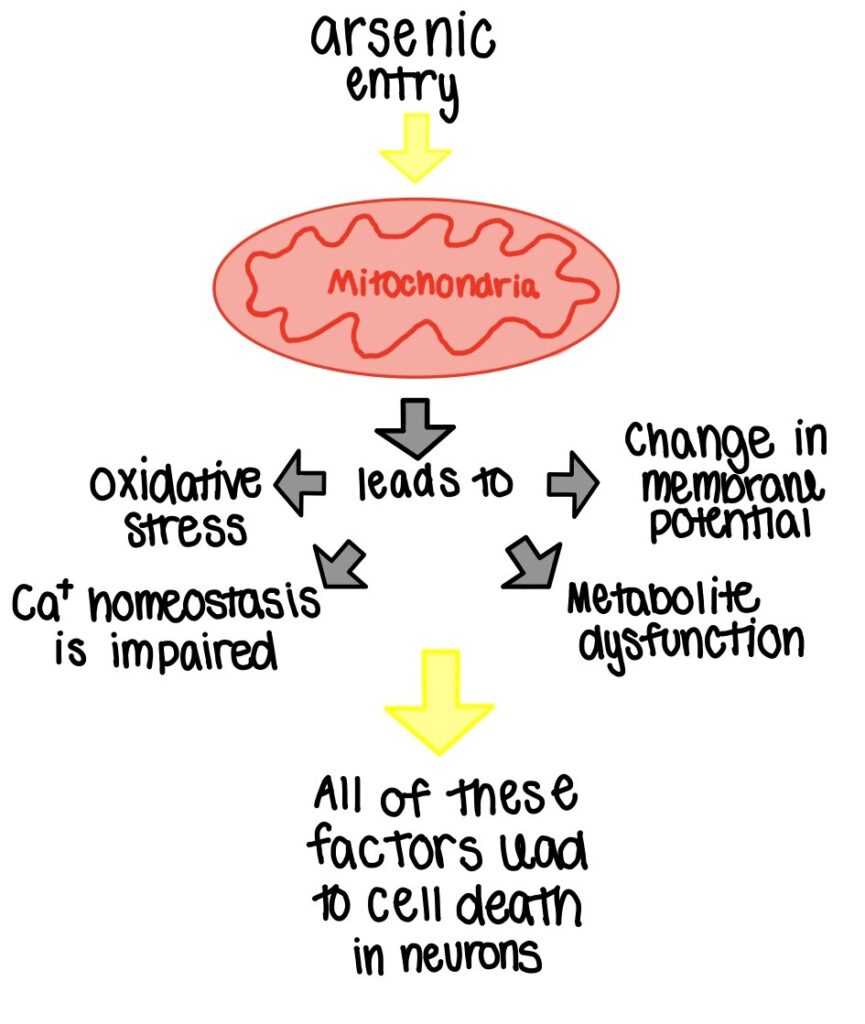 Figure 4. Image depicting the mechanisms of mitochondrial oxidative stress and dysfunction due to arsenic neurotoxicity (Prakash 2015). When arsenic comes into contact with the mitochondria it can have several severe effects including oxidative stress and abnormal functionality. Drawn by Alexis Wilhelm.
Figure 4. Image depicting the mechanisms of mitochondrial oxidative stress and dysfunction due to arsenic neurotoxicity (Prakash 2015). When arsenic comes into contact with the mitochondria it can have several severe effects including oxidative stress and abnormal functionality. Drawn by Alexis Wilhelm.
Arsenate (pentavalent arsenic), is arsenic that has 5 valances and Arsenite (trivalent arsenic), arsenic with 3 valances, is naturally present in the Earth’s crust which can be found in the air, soil, and water (Czerczak 2014). Arsenite is one of the most toxic inorganic formations in comparison to Arsenate. Arsenic poisoning results in a functional disruption of pertinent enzymes necessary to carry out cellular respiration and ATP formation required for the basis of many of functions required for human survival.
Both forms of arsenic are suspected to cause dilation and the allowing of gases and liquids to come through capillaries (Tantry 2015). When arsenite disrupts the body’s function, one example is that molecules and proteins end up lost within the interstitial fluid in the body when the capillaries are dilated and permeable which capillaries will produce excess water moving out ultimately causing tissues to have an unnatural amount of fluid present (Tantry 2015). When tissue has excess fluid the body becomes overhydrated resulting in metabolic derangement, put more simply flushing out your essential metabolites required for proper organ function. When metabolic dysfunction occurs, you can have seizures and possibly put you into a coma.
The link between Arsenic contamination and Agriculture
San Joaquin Valley is made up of 8 counties; San Joaquin, Stanislaus, Merced, Madera, Fresno, Kings, Tulare, and Kern. These 8 counties are some of the most agriculturally productive regions in the entire world and are responsible for cultivating over 250 different crops (University of California 2020). Due to the limitations of water scarcity in the area of the San Joaquin Valley, many farmers have begun using groundwater as a way to supply their crops (USGS c2021). As shown in Figure 6, many of the counties have begun using large amounts of this groundwater supply for agricultural purposes.
 Figure 6. Map of the San Joaquin Valley in regards to groundwater withdrawal. The legend shows that as the colors become redder, that means more groundwater is being withdrawn in the specific area. (CSU 2016). https://www.csustan.edu/sites/default/files/groups/Geography/Images/sjvatlasprojects17.pdf
Figure 6. Map of the San Joaquin Valley in regards to groundwater withdrawal. The legend shows that as the colors become redder, that means more groundwater is being withdrawn in the specific area. (CSU 2016). https://www.csustan.edu/sites/default/files/groups/Geography/Images/sjvatlasprojects17.pdf
Naturally occurring arsenic can be present in groundwater since it is a naturally occurring element generally found in thick clay layers, where it is generally stored (Smith 2018). This presence of arsenic is not usually enough to be considered harmful to humans because it is in extremely low concentrations, below 10 µg/L (p.p.b.). The Corcoran clay level underground is where the highest concentrations of arsenic are found, and as the overpumping continues, these levels continue to increase as arsenic is released into the aquifers from disruption in the Corcoran clay level (Smith 2018). Figure 7 shows how large and industrialized-sized wells penetrate this clay level, and as water is removed from these areas, it has been found that arsenic levels begin to increase in the water due to the shifting of the clay layer. It also happens that the deepest layer of Corcoran Clay is in the most pumped area within the San Joaquin Valley (Smith 2018).

Figure 7. An image describing the layers of groundwater and their depths relative to wells. The Corcoran Clay layer is the layer that contains the highest levels of arsenic in the soil. Most wells for industrial purposes penetrate this layer (State of California 2016).
Most of the arsenic found in groundwater is in its inorganic phase, which is the more toxic form of arsenic (University of Maine c2021). As the pH of the water increases, as in dry/arid conditions of the San Joaquin Valley arsenic is released from the clay and into the water. Since the groundwater levels are increasing in arsenic levels, and the groundwater is being used significantly to cultivate agriculture in the area of the San Joaquin Valley, this is how many individuals can become exposed to arsenic. Arsenic is also used as a pesticide for agriculture (USGS 2017). This means there is a double exposure of arsenic to these areas.
The most affected areas are Kerns, Tulare, and Kings county, which make up a significant portion of the lower San Joaquin Valley which can be seen in Figure 6. This holds implications for environmental injustice as the lower section of the San Joaquin Valley has significantly larger minority populations than the upper section, especially Kern, Tulare, and Kings County which as seen in Figures 8-10.
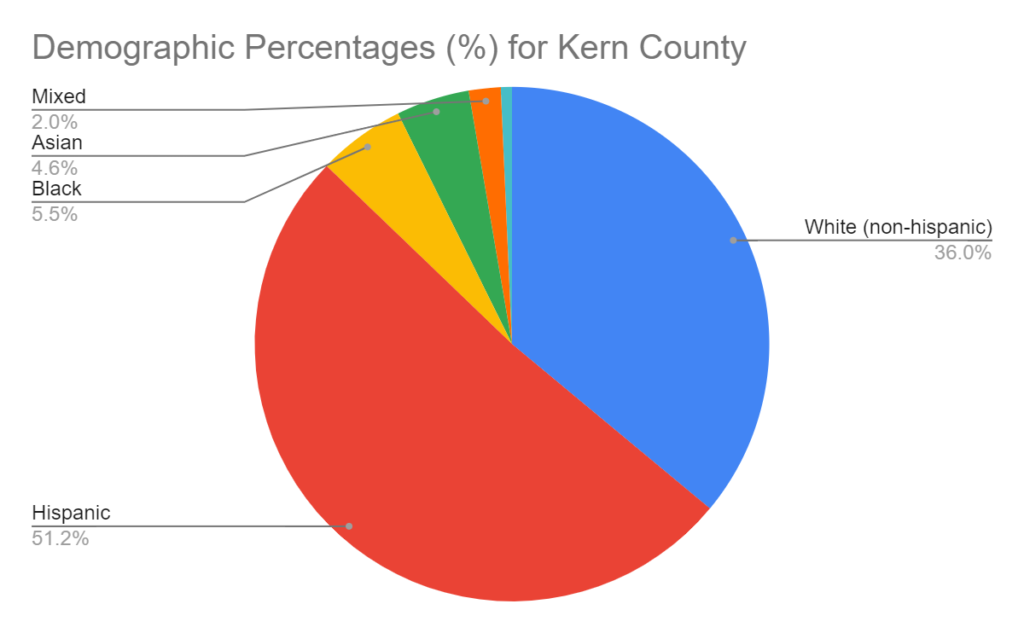 Figure 8. Pie charts of demographics by percentage (%) of Kern County within the lower subsection of the San Joaquin Valley (U.S. Census Bureau c2021). This pie chart was designed using data from the U.S. Census Bureau (c2021). As can be seen, the majority of the population is constituted by minority groups (Hispanic, black, Asian, etc).
Figure 8. Pie charts of demographics by percentage (%) of Kern County within the lower subsection of the San Joaquin Valley (U.S. Census Bureau c2021). This pie chart was designed using data from the U.S. Census Bureau (c2021). As can be seen, the majority of the population is constituted by minority groups (Hispanic, black, Asian, etc).
 Figure 9. Pie charts of demographics by percentage (%) of Tulare County within the lower subsection of the San Joaquin Valley (U.S. Census Bureau c2021). This pie chart was designed using data from the U.S. Census Bureau (c2021). As can be seen, the majority of the population is constituted by minority groups (Hispanic, black, Asian, etc).
Figure 9. Pie charts of demographics by percentage (%) of Tulare County within the lower subsection of the San Joaquin Valley (U.S. Census Bureau c2021). This pie chart was designed using data from the U.S. Census Bureau (c2021). As can be seen, the majority of the population is constituted by minority groups (Hispanic, black, Asian, etc).
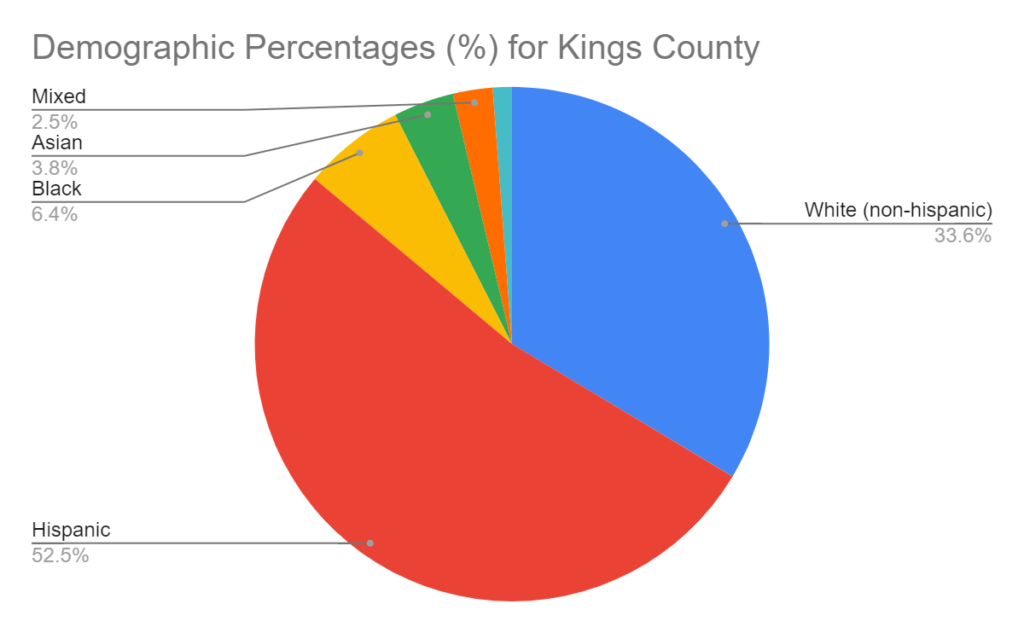 Figure 10. Pie charts of demographics by percentage (%) of Kings County within the lower subsection of the San Joaquin Valley (U.S. Census Bureau c2021). This pie chart was designed using data from the U.S. Census Bureau (c2021). As can be seen, the majority of the population is constituted by minority groups (Hispanic, black, Asian, etc).
Figure 10. Pie charts of demographics by percentage (%) of Kings County within the lower subsection of the San Joaquin Valley (U.S. Census Bureau c2021). This pie chart was designed using data from the U.S. Census Bureau (c2021). As can be seen, the majority of the population is constituted by minority groups (Hispanic, black, Asian, etc).
All three counties have over 60% of their populations made up of minority groups, especially of Hispanic descent (U.S. Census Bureau c2021). The upper section of San Joaquin Valley has a much larger population of white (non-Hispanic) individuals and is also less economically disadvantaged than the lower section of the valley (Balazs 2012). This suggests that there are further implications for environmental injustice due to the large differences in arsenic concentration, related to demographics, and socioeconomic status.
In areas where there is significant socioeconomic disadvantage, the water systems which are supposed to detect arsenic levels and filter them, are often not regulated (Balazs 2012). These areas are most present within the aforementioned Kern, Kings, and Tulare counties, which also have the highest levels of minority groups. Nearly 57% of community water systems within these counties had violations with arsenic levels significantly higher than approved (>10 µg/L) (Balazs 2012). When these systems are not maintained, they allow for dangerous levels of arsenic to present in drinking water for these disadvantaged areas which present a case of environmental injustice.
Clean Water, Where We Stand Now
Due to San Joaquin Valley’s poor groundwater quality, it imposes a great threat to the agriculture and drinking water that is exposed to most rural communities in the area, which also homes the largest populations of Hispanic individuals (Balazs 2012). When it comes to the solution of the water system, and improving the public water, the underlying challenge of this is not just about managing the water system overall, but to provide an equal assessment of the water quality problem. In figure 11 below, it shows the regions in California that are considered to not conform to the water system. Each region in figure 11 shows which types of contaminants are in the water system. Including how the water systems are non-compliant which violates public health’s clean water(Public Policy Institute of California 2019).
To treat the contamination of the water system, investments are needed put into the regions for achieving the success of the water system. Such treatments as treating the water source, or drilling wells into the water are difficult actions for regions that are considered to be more rural since it is not affordable to certain communities. To provide a healthy quality water system, the state, along with urban water systems, including the government within the state of California will need a part in the funding of the water system since rural regions and communities water systems are part of California (Public Policy Institute of California 2019).
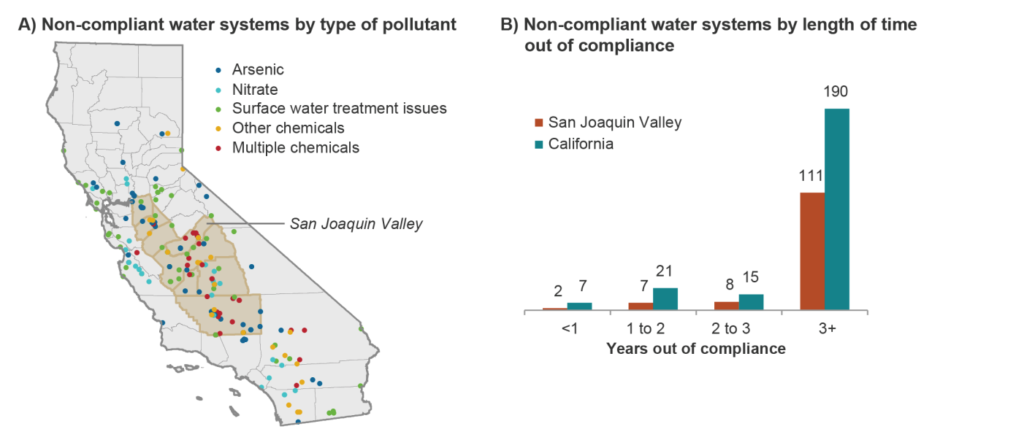 Figure 11. Image of the State of California of regions of non-compliant public water systems. (Public Policy Institute of California 2019).
Figure 11. Image of the State of California of regions of non-compliant public water systems. (Public Policy Institute of California 2019).
For many years the solution to the problem was to provide the counties affected with bottled drinking water, which was paid for by California taxpayers at roughly $540,000. While this did not address the root cause of the problem, there was a new water treatment plant built at a costly 11 million dollars. A portion of the money, $8.5 million, came from the State Water Resources Control Board while $2.5 million came from the United States Department of Agriculture (Western, 2020).
 Figure 12. A portion of a media release announcing the launch of Kettleman City’s new water treatment facility. (California Water Boards 2019)
Figure 12. A portion of a media release announcing the launch of Kettleman City’s new water treatment facility. (California Water Boards 2019)
The new water treatment plant was built in Kings County and it’s promised to provide clean drinking water, free of arsenic. Although this is a victory for those who live in its vicinity, there are some issues regarding whether or not the clean water will flow into the faucets of those who need it the most, the Hispanic community. The new water treatment plant officially opened in late 2019, and a media release addressed this as leaving the “arsenic struggle a thing of the past” (Figure 12). In recent news, the wells have been drying up which is leaving arsenic to concentrate as the aquifers dry out. The aquifers drying out has many implications, and those in charge can redirect the water flow to provide water to those who will benefit from it the most. In the end, with one solution comes another environmental injustice for the Hispanic community in the San Joaquin Valley.
For updates on the San Joaquin Valley water crisis, the following links will redirect you to platforms that continue to monitor the situation.
San Joaquin County: Department of Public Works
https://www.sjgov.org/department/pwk/aboutus?category=divisions&division=Water%20Resources
San Joaquin Valley Latino Immigrants: Implications of Survey Findings for Census 2020
https://cviic.org/wp-content/uploads/2019/01/SJVCRP_Survey_Findings_Report_011819-small.pdf
California Water Boards: State Water Resources Control Board
Waterboards.ca.gov
https://twitter.com/CaWaterBoards/status/1241074214762729472?s=20
California Water Quality Monitoring Council
Water Supply: Peter Vroom, Deputy Director
https://mywaterquality.ca.gov/monitoring_council/index2.html
Balazs CL, Morello-Frosch R, Hubbard AE, & Ray I. 2012. Environmental justice implications of arsenic contamination in California's San Joaquin Valley: a cross-sectional, cluster-design examining exposure and compliance in community drinking water systems. Environmental Health: A Global Access Science Source, 11(1). Congressional Budget Office. 2002. Future Investment in Drinking Water and Wastewater Infrastructure: Appendix C: The 4 Percent Affordability Benchmark for Affordability. Washington: The Congress of the United States [CSU] California State University. 2016. Groundwater Usage in the San Joaquin Valley [internet]; [cited 2021 Nov 04]. Available from https://www.csustan.edu/sites/default/files/groups/Geography/Images/sjvatlasprojects17.pdf Czerczak PS, Ayala-Fierro F. 2014. Arsine. Arsine - an overview | ScienceDirect Topics [internet]; [cited 2021 Nov 5]. https://www.sciencedirect.com/topics/pharmacology-toxicology-and-pharmaceutical-science/arsine Demographics. 2016. San Joaquin Council of Governments [internet]; [cited 2021 Nov 05]. Available from https://www.sjcog.org/236/Demographics Haugen EA, Jurgens BC, Arroyo-Lopez JA, Bennett GL. 2021. Groundwater development leads to decreasing arsenic concentrations in the San Joaquin Valley, California. Science of The Total Environment, 771, 145223. https://doi.org/10.1016/j.scitotenv.2021.145223 Kuivenhoven M, Mason K. 2021. Arsenic toxicity. StatPearls [internet]; [cited 2021 Nov 5]. Available from https://www.ncbi.nlm.nih.gov/books/NBK541125/ Launch of Kettleman City’s New Water Treatment Facility Makes Arsenic Struggle a Thing of the Past. (2019, December). California Water Boards. https://www.waterboards.ca.gov/press_room/press_releases/2019/pr20191218_kettleman.pdf Prakash C, Soni M, Kumar V. 2015. Mitochondrial oxidative stress and dysfunction in arsenic neurotoxicity: A Review. Analytical Science Journals. [cited 2021 Nov 5]. https://analyticalsciencejournals.onlinelibrary.wiley.com/doi/10.1002/jat.3256 Medscape. 2018. Arsenical Keratosis [internet]; [cited 2021 Nov. 05]. Available from https://emedicine.medscape.com/article/1099882-overview#:~:text=Arsenicalsocausespigmentchanges,oflongtermarsenicexposure. San Joaquin Valley is Still Sinking. 2016. NASA Earth Observatory. https://earthobservatory.nasa.gov/images/89761/san-joaquin-valley-is-still-sinking Smith R, Knight R., & Fendorf S. 2018. Overpumping leads to California groundwater arsenic threat. Nature Communications, 9(1). https://doi.org/10.1038/s41467-018-04475-3 State of California. 2016. Framework for a Salt and Nitrate Management Plan for the Central Valley [internet]; [cited 2021 Nov. 5]. Available from https://www.waterboards.ca.gov/centralvalley/water_issues/salinity/past_activities/2016_0622_cvsalts_wkshp_pres.pdf Tantry BA, Shrivastava D, Taher I, Tantry MN. 2015. Arsenic exposure mechanisms of action and related health [internet; [cited 2021 Nov 5]. Available from https://www.hilarispublisher.com/open-access/arsenic-exposure-mechanisms-of-action-an d-related-health-effects-2161-0525-1000327.pdf University of California: Division of Agriculture and Natural Resources. 2020. San Joaquin Valley Agriculture [internet]; [cited 2021 Oct 31]. Available from: https://vric.ucdavis.edu/virtual_tour/sanjoq.htm University of Maine. c2021. Arsenic [internet]; [cited 2021 Nov 5]. Available from https://umaine.edu/arsenic/how-does-arsenic-get-into-the-groundwater/ [USGS] U.S. Geological Survey. c2021. California's Central Valley [Internet]; [cited 2021 Nov 4]. Available from https://ca.water.usgs.gov/projects/central-valley/about-central-valley.html [USGS] U.S. Geological Survey. 2017. Groundwater Quality in the Western San Joaquin Valley Study Unit, 2010: California GAMA Priority Basin Project [Internet]; [cited 2021 Nov 4]. Available from https://pubs.usgs.gov/sir/2017/5032/sir20175032.pdf U.S. Census Bureau [internet}. c2021. Washington (DC): U.S. Census Bureau; [cited 2021 Nov. 26]. Available from https://www.census.gov/en.html U.S. Census Bureau. 2016. QuickFacts: San Joaquin County, California [internet]; [cited 2021 Nov 05]. Available from https://www.census.gov/quickfacts/sanjoaquincountycalifornia [WHO] World Health Organization. 2018. Arsenic [internet]; [cited 2021 Nov. 05]. Available from https://www.who.int/news-room/fact-sheets/detail/arsenic Western, W., Jr. (2020, March 25). A Valley community can finally clean its water – if it receives any. The San Joaquin Valley Sun. https://sjvsun.com/ag/a-valley-community-can-finally-clean-its-water-if-it-receives-any/ Wikimedia. 2019. Arsenic Poisoning [internet]; [cited 2021 Nov. 05]. Available from https://commons.wikimedia.org/wiki/File:Arsenic_posioning.gif Wikimedia. 2012. Arsenic Contamination Areas [internet]; [cited 2021 Nov 05]. Available from https://commons.wikimedia.org/wiki/File:Arsenic_contamination_areas.jpg Wikimedia. 2010. San Joaquin River Map [internet]; [cited 2021 Nov. 05]. Available from https://commons.wikimedia.org/wiki/File:SanJoaquinRiverMap.jpg Hanak, E., Et. al. 2019. Water and the Future of the San Joaquin Valley. Public Policy Institute of California [Internet]; [cited 2021 Nov 5] https://www.ppic.org/wp-content/uploads/water-and-the-future-of-the-san-joaquin-valley-february-2019.pdf

Provide Feedback